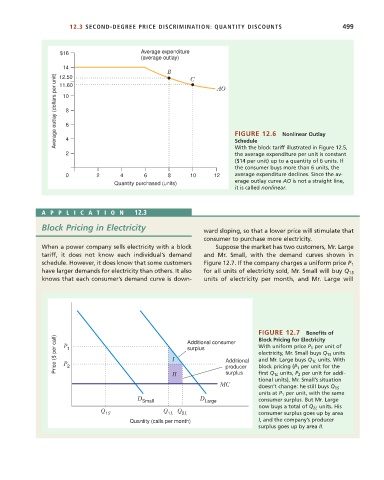Page 525 - Microeconomics, Fourth Edition
P. 525
c12capturingsurplus.qxd 8/18/10 2:29 AM Page 499
12.3 SECOND-DEGREE PRICE DISCRIMINATION: QUANTITY DISCOUNTS 499
$16 Average expenditure
(average outlay)
14 B C
Average outlay (dollars per unit) 10 8 6 AO
12.50
11.60
Schedule
With the block tariff illustrated in Figure 12.5,
the average expenditure per unit is constant
2 4 FIGURE 12.6 Nonlinear Outlay
($14 per unit) up to a quantity of 6 units. If
the consumer buys more than 6 units, the
0 2 4 6 8 10 12 average expenditure declines. Since the av-
erage outlay curve AO is not a straight line,
Quantity purchased (units)
it is called nonlinear.
APPLICA TION 12.3
Block Pricing in Electricity
ward sloping, so that a lower price will stimulate that
consumer to purchase more electricity.
When a power company sells electricity with a block Suppose the market has two customers, Mr. Large
tariff, it does not know each individual’s demand and Mr. Small, with the demand curves shown in
schedule. However, it does know that some customers Figure 12.7. If the company charges a uniform price P 1
have larger demands for electricity than others. It also for all units of electricity sold, Mr. Small will buy Q 1S
knows that each consumer’s demand curve is down- units of electricity per month, and Mr. Large will
FIGURE 12.7 Benefits of
Price ($ per call) P 1 I surplus Additional With uniform price P 1 per unit of
Block Pricing for Electricity
Additional consumer
electricity, Mr. Small buys Q 1S units
and Mr. Large buys Q 1L units. With
2
P
surplus
first Q 1L units, P 2 per unit for addi-
II producer block pricing (P 1 per unit for the
tional units), Mr. Small’s situation
doesn’t change: he still buys Q 1S
MC
units at P 1 per unit, with the same
D Small D Large consumer surplus. But Mr. Large
now buys a total of Q 2L units. His
Q Q Q consumer surplus goes up by area
1S 1L 2L
Quantity (calls per month) I, and the company’s producer
surplus goes up by area II.

